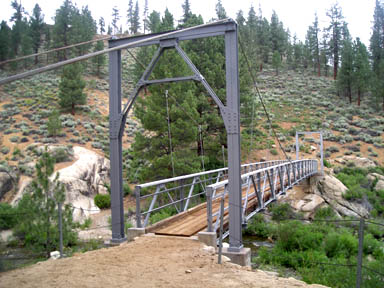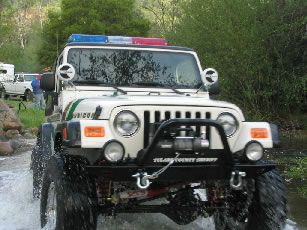This last full moon, I backpacked up to the Kern Canyon stock bridge in Sequoia National Park. I started at Lewis Camp Trailhead, in Sequoia National Monument, just outside the southern boundary of the Golden Trout Wilderness. This trailhead sits near the top of the Western Divide, on the historic Jordan Trail. For many trips that begin there, the trailhead is the highest point of the trip (7600 feet).
Tulare County Sheriff SAR Jeep
I pulled into the part of the dirt lot reserved for foot-bound travelers and parked, only to be directed by a Sheriff’s deputy to another spot, to make room for the SAR (search and rescue) workers expected to arrive soon. There was already quite a showing of force: a trailer, a jeep, a couple ATVs, and several other vehicles. Word had it that a man who had been suffering from seizures was lost on the nearby slopes.
About 15 minutes down the trail, I realized that I’d left my wilderness and fire permits in the car. That seemed rather ironic, after having driven four hours to get to the ranger station just before closing time, only to leave the permits in the car. Oh well. Never fails. I always forget something. I decided to take my chances with the rangerfolk, rather than add 30 minutes to my evening hike.
I few minutes later, I encountered a group of cattle, who spooked with no more than a mutual glance, and kicked up a cloud of dust in their panic.
I bounded down the 1900 foot descent, past Jerky Meadow and Jug Spring (a watering hole for animals and the desperate), and arrived at the Little Kern horse bridge just after 8pm, with an hour of dusk to spare. I suffered from a typical spell of outback anxiety along the way, which means I missed my wife and kids terribly and felt guilty about being so selfish as to take this time to myself. Perhaps the evening shadows settling over the mountainside were affecting me. There is something ominous about the onset of nightfall when one has not reached one’s destination, though the night itself can seem quite comforting. Almost predictably, the anxiety disappeared as I settled in for the night.

The bridge over the Little Kern. Note the granite and basalt layers.
Two of the three campsites were occupied by SAR folk, so my choice was easy. I filtered some river water, had some trail mix for dinner, and unrolled my sleeping bag. I enjoyed the warm light of the fire at the camp across the river, laid back, and watched the stars appear one by one.
Antares—the heart of the Scorpion—flared red, like a campfire in the sky, not so remote as the astronomers calculate. I spotted a falling star, and watched a dim, red satellite make its way around and around the planet, first past Lyra toward the pole, then past Cygnus a little while later. Jupiter peeked through the ridgetop trees across the river. The full moon didn’t rise over the tail of the Great Western Divide until I had fallen asleep. I would waken occasionally, as see the Moon chasing Jupiter from west to east.
A full moon can be useful if one needs to get around camp without a light, or if one needs to travel by night, but it can disturb one’s sleep, rather like leaving the bedroom light on, and a moonless sky is certainly preferred by the stars.
